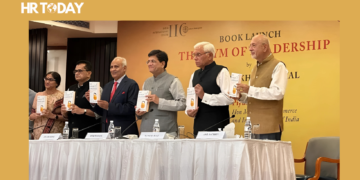In my Consulting Journey I was engaged to design a Reward and Recognition Plan for a young KPO with a median age of 28 Years. To start with Irested the Model on four pillars : Inclusivity & Equity, Process & Outcome Integrity , Core Values & Principle of Customer First. My experience was doubly enriched with the expectations of the employees who created these recognizable “ Moments of Truth” and Leadership Iterations. Flawless Execution, I knew would put this Plan to Test , if it had to effectively impact all stakeholders.
What could derail this Plan, how could it be made more meaningful and relevant to the employees, Can appreciation really drive superior performance in a world dominated by Esops & Bonuses, why not keep it informal & spontaneous , were some concerns that continued to bother me.
These questions propelled my quest to delve deeper into the subject and I knew no better than this first hand read of the Book by Debra Corey. It validated most of my understanding and answered some of my open questions.
The Title as Corey says is a “Call to Action” to make Recognition a Habit. The book seems to be well researched as the Author relies on Global Recognition Report 2017, BCG Study 2014, Gallup and others to establish her points. The case lets and insights leave you with a practical framework. Every Chapter ends with an appropriate Quote which captures its essence.
The Author terms “ Appreciation & Recognition” as the “ Superpower “ for their impact on the Organization and the Employees. Her conviction is supported by several cited Reports.
Shawn Anchor in his book “ Happiness Dividend” shows that Employee Productivity can increase 30% a day on receiving praise. Companies that recognize their employees are 12 times more likely to generate strong business results than their peers according to Josh Bersin 2012. A 2016 Gallup Report stated that for 82% Employees recognition was a leading factor in improved job performance , reduction in sick days and attrition. As per the Global Culture Report 21 , 37% of the employees interviewed said recognition scored over pay and promotions. Deloitte Studies report that recognition builds 14% higher engagement and enhances trust between employees and their Managers.
Underlying improved performance is the secretion of happy hormones by the body due to praise and respect for their work. Recognition makes Employees feel important , reinforces a positive sense of self-worth, engender a feeling that they matter and that their contribution is truly making a difference. It helps them know they are on the right track. Recognition works like the emotional contagion in groups and its ripple effect gets amplified creating positive reciprocity by rippling the impact on the receiver and multiplying the numbers receiving recognition.
If this be the power of recognition, what holds Managers back? From her experience, the Author avers some Managers do not think it is of importance personally and hence do not think it is their responsibility. Others find it time consuming , costly and avoid it for lack of skills. Her Book as the Title suggests is a “Call to Action” for these Managers as there are not good enough reasons to “ hold back”. She Urges Managers to Wear their “ Recognition Glasses” and look for opportunities to appreciate. Then make it happen by choosing words wisely and Say it. Lastly & Importantly Appreciate them genuinely making them feel valued and noticed by others.
According to her Recognition Tools Fall into Two Main Categories – Formal & Informal. Both can be used in combination and much would depend on the scope and impact of the action and demonstrated behaviour. As the plan matures Recognition can become increasingly effective if it is customized to the aspirations and preferences of the Receiver.
Recognition creates Memory Moments for Years to Come. She suggests a Structured approach to “ Informal Recognition” in the form of Growth and Development Opportunities Thoughtful Gifts, Time Off to for themselves or for pursuit of their passion,Communications as Shoutouts for their efforts. Underlying all this must be a deep alignment between recognition and the impact of their contribution.
The Author introduces us to the Four Golden Rules of Recognition via MUST ( Acronym) –
- Make it Meaningful related to Impact.
- Ensure it is Unified & Inclusive. Provide Equal Opportunity to all to give and get recognized.
- Spotlight your recognition so it uplifts all receivers & others, it reinforces what is valued.
- Timely not making employees wait till a time it loses its lucre and impact.
Remove the Winner vs Loser Mentality changing recognition to being a motivator not a demotivator and minimizes negative “ Eye Rollers”. Remove Constraints & Guardrails allowing Motivation to flow freely in a fair continuous & consistent manner.
Traditional Practices of recognition should not hold you back and at the same time Best Practices may not be suited for replication. Every Organization must develop its own signature style of recognition. Use employee feedback , measure impact to drive changes.
Do not just recognize “big wins” or “episodic events“ Recognize “Non Scale Victories” . End Results are important but so is the whole process, knowledge , efforts and expertise.
Other than formalizing existing practices, use the crowd source approach – enlist help of the employees themselves, to capture all the recognition moments ,
Hybrid/ Work from Home Settings could derail the plan. The author suggests an innovation by way of setting up a “Kudos Channel” and a Digital Recognition Wall on a Microsoft Platform for instant appreciation flowing from peers as well.
A Unique way to recognize is to blend a Standard Communication with a Personalized Note handwritten by the Manager recognizing individual contribution.
Recognizing Employees by providing them opportunities to teach, train , shadow their Managers, asking them to resolve a complex business problem , presenting at Leadership Meets, delegate authority not tasks only and Monthly appreciation Videos from Customers are suggested as ways of keeping Recognition effective and fresh.
Wrapping it up: A Quote I found to be very Powerful from Eric Hutcherson : “I believe the World is big enough that everyone can have success, you don’t have to lose in order for me to win. We can all co- exist and all have an equal opportunity to be recognized”
The Book could serve as a Primer for the Younger Generation of HR Professionals, those who have matured in this Practice could do with a reference to this Review.









